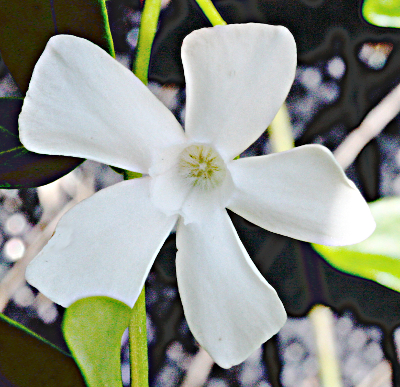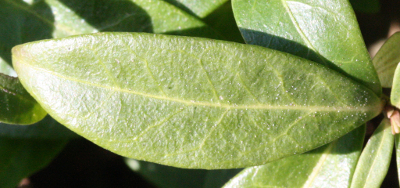Lesser periwinkle |




Das Kleine Immergrün besitzt meist blauviolette, seltener weiße Blüten und längliche, glänzende Blätter
| Vinca minor L.: | |
| Blooming period: | March–July, flowering for the second time in September/Oktober |
| Height: | 10–20 cm |
| Flowers: | bisexual, actinomorphic, Ø 20–30
mm, stamens: 5, styles: 1 |
| Corolla: | 5-lobed, mostly blue-violet |
| Sepals: | 5, fused at the base |
| Stem leaves: | opposite, lanceolate |
Plants perennial, slightly woody at the base.
Stem creeping, young shoots upright.
Leaves oblong to lanceolate, entire, 2-5 cm long, dark green, leathery, glossy on the upper side, veins prominent. Margins not ciliated, petioles bare.
Flowers in the leaf axils of young shoots, stalked, blue violet, light blue or red-purple, rarely pink or white.
The 5 petals are asymmetrically, the lobes twisted to left and are fused at the base to a small tube.
Calyx with lanceolate teeth.
From the superior ovary, consisting of 2 fused carpels, after insect pollination develop a pair of narrowly cylindrical follicles with few seeds.
The plant rarely bears fruits, but spreads mainly with their long shoots, which are rooting at the nodes. Plant poisonous, evergreen.
There are several subspecies, varieties and cultivated forms of the lesser periwinkle.
| Floral formula: |
| * K(5) C(5) A5 G(2) superior |
Occurrence:
Deciduous
and mixed forests. Prefers slightly moist locations.
Distribution:
Wild
or feral in Central and Southern Europe, Asia Minor, Iran. Originally
Southern Europe.